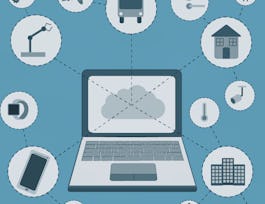IoT (Internet of Things) devices are already abundant, but new products that include IoT modules are now a common trend. Also, almost everything is already connected to a Cloud, and much more will be in the future. Naturally, as this trend continues, in the near future almost all devices and appliances will include IoT modules which will use sensor data collection and control/management based on Clouds. Since we will live in an IoT world supported by Clouds, knowledge of the core technologies and platforms of IoT and Clouds will enable you with the tools to become a true leader in the future product and business world. In this course, the start-of-the-art IoT and wireless networks and Cloud technologies are introduced (for details on 1G to 5G mobile communications and smartphone and smart device technology, please take my course “Smart Device & Mobile Emerging Technologies”). This course ends with projects that teach how to analyze Bluetooth and W-Fi wireless networks and setup and use an EC2 (Elastic Compute Cloud) Virtual Computer in AWS (Amazon Web Service), which is the most powerful and popular Cloud technology in the world. Comparing to the human body, IoT is the neural network and the Cloud is the brain. Thus, I cordially welcome you into the brain and neural network of the future intelligence world!



IoT (Internet of Things) Wireless & Cloud Computing Emerging Technologies
This course is part of Emerging Technologies: From Smartphones to IoT to Big Data Specialization

Instructor: Jong-Moon Chung
Sponsored by PTT Global Chemical
67,534 already enrolled
(1,178 reviews)
Skills you'll gain
Details to know

Add to your LinkedIn profile
10 assignments
See how employees at top companies are mastering in-demand skills

Build your subject-matter expertise
- Learn new concepts from industry experts
- Gain a foundational understanding of a subject or tool
- Develop job-relevant skills with hands-on projects
- Earn a shareable career certificate


Earn a career certificate
Add this credential to your LinkedIn profile, resume, or CV
Share it on social media and in your performance review

There are 6 modules in this course
The first module “IoT Business & Products” focuses on the influence of IoT and provides an overview of the trends in North America and the world’s IoT market and industry. The differences in IoT products and services are also described followed by an introduction of the types of leading IoT companies and products, which include Atmel, Android Things, Samsara, ZingBox, and Uber. In addition, IoT services types (i.e., M2M, M2P, P2M, P2P) and their economic impact and the advantages of IoT applications as well as the IoT & M2M ecosystem are introduced.
What's included
9 videos2 assignments
The second module “IoT Architecture & Technologies” focuses on the functionality and characteristics of the IoT architecture layers as well as the characteristics of IoT technologies, which include WSN (Wireless Sensor Networks), IoT cloud computing, IoT R&D (Research & Development), and IoT hardware technologies. Further details are provided in the descriptions of the characteristics of IoT sensors types, actuator types, and RFID types as well as the functionality and characteristics of IoT device platforms, which include the Arduino, Raspberry Pi, and BeagleBoard products. Next, a comparison of the representative IoT developer platform products is presented, which include the Raspberry Pi, Raspberry Pi 3 Model B, BeagleBoard, Beaglebone Black, and the Arduino systems Uno R3 (for entry and general purpose), Yun (for IoT), and Lilypad (for wearable).
What's included
9 videos2 assignments
The third module “IoT Networks” focuses on the functionality and characteristics of IoT wireless networks, the IoT network architecture, and wearable IoT networks. To describe the frequency requirements, the characteristics and requirements of the ISM (Industrial, Scientific and Medical) band are introduced. Next, the functionality and characteristics of IoT wireless communication technologies based on WLAN (Wireless Local Area Network), WPAN (Wireless Personal Area Network), and LPWAN (Low-Power Wide Area Network) are described. Then further details on WPAN (which include Bluetooth, ZigBee, 6LoWPAN, and IEEE 802.15.4 technology) and LPWAN (which include LoRa, UNB, Sigfox, and NB-IoT) are provided. In addition, the advantages of IoT and 5G mobile communication networks and the characteristics of mMTC (massive MTC) is covered.
What's included
9 videos2 assignments
The fourth module “Wi-Fi & Bluetooth” focuses on the details of Wi-Fi and Bluetooth technology. First, Wi-Fi technology and the WLAN (Wireless Local Area Network) market is introduced, followed by a description of the functionality of Wi-Fi transmission modes (which include the Infrastructure mode and the Ad-Hoc mode) and wireless APs (Access Points) as well as BSS (Basic Service Set) and ESS (Extended Service Set) network formations. The internal process of Wi-Fi operations and role of DCF (Distributed Coordination Function) and CSMA/CA (Carrier-Sense Multiple Access with Collision Avoidance) are described followed by the characteristics of Wi-Fi standards (which include the IEEE 802.11a, 11b, 11e, 11g, 11n, 11p, 11ac, 11ad, 11ah specifications), Wi-Fi PHY (Physical Layer) modulation schemes, as well as the IFS (Inter-Frame Space) types and how IFSs are used in priority access control. In addition, the advantages of Wi-Fi Dual Band and Wi-Fi Direct are introduced. Second, Bluetooth standards and feature evolution are introduced, which include the specifications from 1.1 to 5 including EDR (Enhanced Data Rate), HS (High Speed), BLE (Bluetooth Low Energy), and Beacon technology. The description incudes the characteristics of Bluetooth piconets and types of operations (which include Classic Bluetooth and BLE (Bluetooth Low Energy)) as well as the channel specifications, advertising, and connection events.
What's included
11 videos2 assignments
The fifth module “Cloud Technology” focuses on the Cloud market analysis, Cloud service types, MCC (Mobile Cloud Computing), and Edge Computing technology. Frist, the characteristics of the world’s top cloud companies and their services including AWS (Amazon Web Service), Microsoft, IBM, Google, and Apple's iCloud are introduced. Then the characteristics of cloud models, which include public cloud, private cloud, community cloud, and hybrid cloud are described along with the differences in cloud service models, which include SaaS (Software as a Service), PaaS (Platform as a Service), and IaaS (Infrastructure as a Service). Based on the service models, the benefits and characteristics of Cloud services are introduced. More details on the operation process are introduced, which include the IaaS and VM (Virtual Machine) administration, PaaS Runtime Environment for application support, and Open SaaS applications access processes. Then the relation between IoT and state-of-the-art mobile cloud technology is introduced. First the differences in MCC (Mobile Cloud Computing) and Edge Computing are described, which includes details on Fog computing, MEC (Mobile Edge Computing), and Cloudlet technology. In addition, the functionality and characteristics of the Cloudlet architecture and its 3 layers are covered.
What's included
10 videos2 assignments
The sixth module “IoT Bluetooth & Wi-Fi & AWS EC2 Project” focuses on three IoT projects to provide experience in Bluetooth, Wi-Fi, and AWS (Amazon Web Service) EC2 (Elastic Compute Cloud) system details. The first project provides experience on the operation process of Bluetooth in Android and iPhone smartphones, teaching how to scan a Bluetooth packet and identify different Bluetooth versions being used on a smartphone. The second project provides experience on the operation process of Wi-Fi in Android and iPhone smartphones, teaching how to use a Wi-Fi network analyzer, conduct a LAN scan, send ping to a gateway, conduct a Wi-Fi signal scan, and use a Wi-Fi channel graph. The third project provides experience on how to setup an EC2 (Elastic Compute Cloud) Virtual Computer in AWS (Amazon Web Service) and how to use various options and compute a process on EC2 and use S3.
What's included
3 videos1 peer review
Instructor

Offered by
Why people choose Coursera for their career




Learner reviews
1,178 reviews
- 5 stars
72.49%
- 4 stars
22.41%
- 3 stars
3.56%
- 2 stars
0.76%
- 1 star
0.76%
Showing 3 of 1178
Reviewed on Jul 25, 2021
Good course for beginners who wants to learn about IOT,cloud computing and wireless technologies.If you want to start your carrier in these fields then definately take these course.
Reviewed on Dec 16, 2020
Covers the domain thoroughly. Well prepared slides summarize critical issues properly. Tutor is successful in passing his motivation. Could be a little more theoretical.
Reviewed on Aug 31, 2021
An interesting & learning opportunity into future technologies & IoT. Found it eye opening to what processes & systems run without most people giving it a second thought.
Recommended if you're interested in Information Technology

University of Illinois Urbana-Champaign

L&T EduTech

Illinois Tech

Open new doors with Coursera Plus
Unlimited access to 10,000+ world-class courses, hands-on projects, and job-ready certificate programs - all included in your subscription
Advance your career with an online degree
Earn a degree from world-class universities - 100% online
Join over 3,400 global companies that choose Coursera for Business
Upskill your employees to excel in the digital economy



